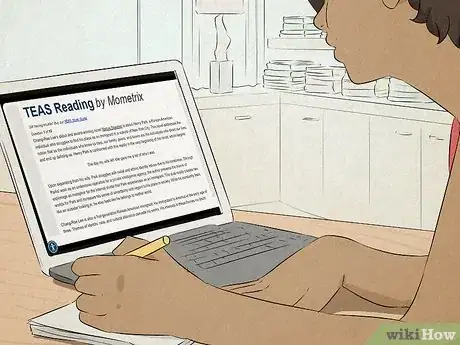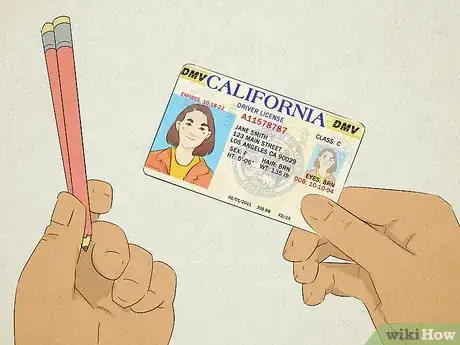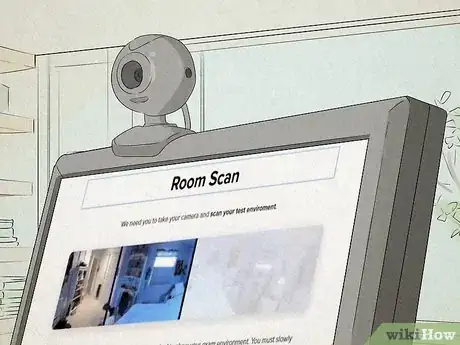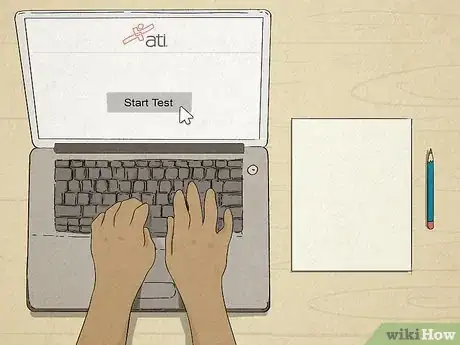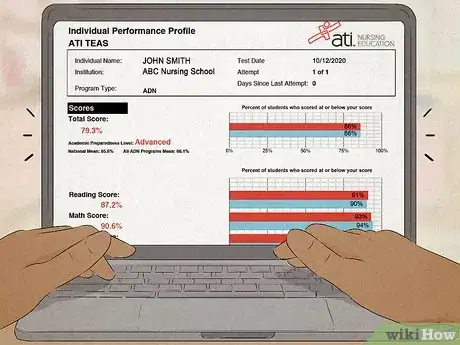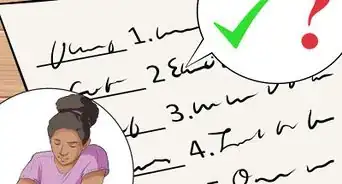This article was co-authored by Ted Dorsey, MA and by wikiHow staff writer, Amy Bobinger. Ted Dorsey is a Test Prep Tutor, author, and founder of Tutor Ted, an SAT and ACT tutoring service based in Southern California. Ted earned a perfect score on the SAT (1600) and PSAT (240) in high school. Since then, he has earned perfect scores on the ACT (36), SAT Subject Test in Literature (800), and SAT Subject Test in Math Level 2 (800). He has a BA in English from Princeton University and a MA in Education from the University of California, Los Angeles.
There are 14 references cited in this article, which can be found at the bottom of the page.
This article has been viewed 4,957 times.
If you're planning to go to nursing or allied health school, you'll likely need to take the TEAS (Test of Essential Academic Skills) Exam before you can be admitted. The test covers basic knowledge in four areas: reading, math, science, and English and language. It might sound a little intimidating, but if you give yourself plenty of time to study, you'll have the best chance of success!
Steps
Registration
-
1Contact the school you're applying to for important exam info. Call the admissions office and ask about the school's requirements for taking the TEAS Exam—some schools offer the test themselves, some will have you take it online, and others will ask you to go to a testing center. You'll need to know that information when you register for the exam.[1]
- In addition, ask about the school's deadline for submitting your results, how long you have to wait between attempts, and what score you need to get in order to pass—it varies between schools.[2]
- If you're applying to more than one school, contact your first-choice school first. You can then send the transcripts to the other schools on your list.
- Some schools may have different registration requirements for the test. If so, follow the instructions that are given to you.
-
2Go to https://www.atitesting.com/teas-prep to register. Once you're ready to register, visit ATI's registration page for the TEAS Exam. Click "Start Registration," then either create an account or sign in if you already have one. Then, follow the on-screen instructions to register.[3]
- Make sure you write down your ATI login and password. You'll need to have this information the day of your exam—if you don't have it, you won't be allowed to take the test.
Advertisement -
3Include all of the schools where you want your scores sent. When you're asked to select your institution, choose every school that you're applying to. If you don't, you'll have to purchase transcripts and send them to those schools after you take the exam.[4]
- There may be a fee to have your test results sent to multiple schools.
- If the test you're taking is administered by a school, they'll automatically receive those test results.
-
4Verify that you meet the requirements if you're taking a remote test. Some schools will allow you to take a remote-proctored exam, meaning you can take it from home. However, your computer and internet speeds will need to meet certain specifications:[5]
- Browser must be Google Chrome Version 77 or later.
- Have a PC (Windows 10 or later, minimum resolution 1024x600) or a Mac (Mac OSX 10.11, minimum resolution 1024x600). You cannot use a phone or tablet.
- Enable Javascript and cookies
- Disable popup blocker in Chrome browser
- Have a microphone and webcam (minimum resolution 320x240 VGA)
- Internet speed is 0.5-1 Mbps. (You can test this by going to https://www.speedtest.net.)
-
5Choose a date at least 6 weeks out, if you can. When prompted, select the date for your exam. It's best to give yourself at least 6 weeks to study. However, you may also want to leave enough time that you can retake the exam if you don't pass it on the first try. Some schools require you to wait a certain amount of time before you can take the test again, so be sure to factor that in.[6]
- Once you choose your date, click "Learn More" for important information about that test date.
- If you're testing at PSI, you'll register for your test date separately. Check the verification email you receive after you register for this information.
- Keep in mind that you typically can not reschedule the test once you register.
Study Resources
-
1Purchase a review guide, like the ones from ATI. There are a number of different companies that offer prep materials for the TEAS Exam. However, ATI is the company that creates the test, so many students prefer to use their materials to help them study for the exam.[7]
- ATI offers different packages for studying—you can get anything from a basic study guide to a comprehensive collection of subject-specific guides and practice tests that mimic the real exam.
-
2Check out ATI's Facebook page for prep events. Occasionally, ATI will host live events for TEAS prep where they share test prep questions, helpful hints about the exam, host Q&As, and more. If you're on Facebook, follow their page and sign up to be notified any time you go live![8]
- You can find their page at https://www.facebook.com/ATINursingEducation/.
-
3Read ATI's student blog for tips and practice questions. ATI's blog has a ton of information about the TEAS Exam. Scroll through their old blog entries for helpful tips as you're preparing for the test, and check back regularly for new updates.[9]
- Visit the ATI student blog at https://atinursingblog.com/category/pre-nursing-prep/.
-
4Take practice assessments to test how well you're doing. Practice tests from ATI are formatted just like the real exam. Take them periodically throughout your study period to get an idea of where you need a little extra help. Try not to check your notes or get any other outside help when you take the practice tests to make it more like the real thing![10]
- For instance, if you do well in the Math portion overall, but you missed a few questions about fractions, you might spend a little more time studying fractions.
- If you take the practice assessments as seriously as you would the real test, you'll get a realistic idea of what your score will be.
Exam Topics
-
1Practice reading passages for the Reading section. Use your study guide or search online for practice passages with questions. Typically, it's best to read the questions first, then read the passage—and pay close attention to the wording of each question. That way, you'll have a good idea of what to look for as you read.[11]
- When you're reading test passages, try to find the main idea and identify supporting details. Think about logical conclusions you could draw from the passage, and practice sorting out fact from opinion.[12]
- Try to find passages in a variety of writing styles, like persuasive and informational.
-
2Study arithmetic, fractions, and percentages for Math. Brush up on the basics like addition, subtraction, multiplication, and division. Also, make sure you're comfortable working with fractions, ratios, percentages, and decimals.[13]
- Especially practice converting back and forth between fractions, percents, and decimals. You'll also need to be comfortable reading tables, charts, and graphs.[14]
- You will be provided with a basic 4-function calculator for the exam.
-
3Brush up on anatomy, biology, and chemistry for Science. If you're only going to buy prep materials for one subject, Science is probably your best best. You'll need to know about anatomy and biology, chemistry, physics, and physical sciences.[15]
- Study bodily systems—like the respiratory, cardiac, digestive, reproductive, and circulatory systems. You'll also need a working knowledge of things like nutrition, population growth and decline, and the periodic table.[16]
-
4Study grammar and spelling for English and Language usage. English and Language usage is a little different from the Reading section. It's not about how well you comprehend what you read, but more about your ability to identify correct (and incorrect) sentence structure, spelling, punctuation, and grammar.[17]
- Spend some time reviewing common prefixes and suffixes—those can give you helpful hints to word meanings during the exam.
-
5Study for a few hours each day leading up to the test. Don't try to cram everything in the week before your test. Instead, make a plan to study a little at a time. Give a little more time to subjects you find more challenging, but make sure you spend a little time on each of the 4 main test topics![18]
- You can break down your studying in whatever way makes the most sense to you. Check out this sample plan from ATI for an idea of what might work for you: https://f.hubspotusercontent00.net/hubfs/1270502/10-2020_TEAS-6-week-study-plan.pdf?utm_referrer=https%3A%2F%2Fatinursingblog.com%2F
In-Person Testing
-
1Bring your ID and two No. 2 pencils on test day. On the day of the test, go to your testing location. Be sure to bring a government-issued ID and two sharpened No. 2 pencils with erasers. Unless you're instructed otherwise, don't bring anything else to the testing center.[19]
- Make sure you have your ATI username and password, as well.
- Only official forms of identification—like a driver's license, state-issued ID, passport, or green card—will be accepted. Student IDs, temporary licenses, and credit card photos will not work.
- Don't bring extra clothing, like coats, hats, sunglasses, or items like purses, backpacks, cellphones, calculators, or smart watches.
-
2Check in with the testing staff when you arrive. Once you get to the testing center, give the staff your ID and your ATI login information. They'll verify your identity and make sure you don't have anything you're not supposed to have.[20]
- After you're checked in, the staff will admit you to the testing room and show you to your seat.
-
3Pace yourself so you can finish each section. The TEAS Exam is made up of 170 multiple-choice questions, and you'll have 209 minutes in total to finish the test. If you're not sure of an answer, it's fine to skip it, but try to keep moving at a steady pace so you can come back and finish any questions you skipped.[21] The test is broken down as follows:
- Reading: 53 questions, 64 minutes
- Math: 36 questions, 54 minutes
- Science: 53 questions, 63 minutes,
- English & Language Usage: 28 questions, 28 minutes
-
4Try not to skip hard questions. On the TEAS Exam, not all of the questions are graded equally. You won't know which questions are worth more, but in general, the harder questions will be more weighted. If you need to circle back to a question, that's fine, but since each question is multiple-choice, it's best to at least guess an answer—you'll have a 1 in 4 chance of getting it right.[22]
- Try to narrow down the answer by eliminating any choices that are definitely not right. That will improve your chances of guessing correctly.
-
5Use your calculator and scratch paper for the Math section. When you arrive for the test, you'll be given a 4-function calculator and a single piece of scratch paper. You can use both of those to help you answer questions during your exam.[23]
- If you're taking the test on a computer, there will be a drop-down calculator on your screen.
- You'll have to return the scratch paper to the proctor after you finish your exam.[24]
-
6Get the results right away or after 2 days. The school chooses when you'll get your results. In most cases, you'll get them right away. However, some schools require you to wait 2 business days before they'll release your results, so be sure to ask.[25]
- Your score will be broken down into a Total Score, a score for each section of the test, and sub-content scores for different concepts within each section.[26]
Testing Remotely
-
1Login to the test at https://www.atitesting.com. Enter your ATI username and password. Then, select the "Test" tab, choose your exam, and click "Begin."[27]
- It's best to log in about 15 minutes before your test starts to ensure you have plenty of time to get set up.
-
2Follow the on-screen instructions for the camera test and room scan. Adjust the camera so your whole face and the top of your head are visible on the screen. Typically, you'll have to do a test to make sure your camera is recording a clear picture. Then, the proctor may ask you to do a room scan, where you'll show your desk and the area around you.[28]
- During the room scan, the proctor will ensure you don't have any study materials or other unauthorized items nearby that might disqualify you from taking the exam.
- You may also be asked to show your government-issued ID.
- Be sure you're in a well-lit space so the camera can get a good picture of you.
-
3Have one blank piece of paper for the exam. Just like for an in-person exam, you'll be allowed to use a single piece of scratch paper during the test. When you're asked, hold the paper up and show the front and back to the proctor so they can be sure there's nothing written on it.[29]
- You'll be asked to destroy the paper after the test is over.
-
4Click the "Start" button to start the test once you're approved. Once the proctor tells you that you're good to begin the test, click the "Start" button on your screen. At that point, the test will start—do not refresh your screen or exit out of the test after that point. Also, keep your eyes on the screen, don't open any other web pages, and don't attempt to use copy or paste on your computer.[30]
- Don't talk to anyone else or have anyone else in the room during your test.
- If you need to take a break, you can pause the test for up to 5 minutes.[31]
- There's also a live chat button in case you have any problems during the test.
-
5Receive your results as the school has directed. In most cases, you'll be able to see your test results immediately. However, each individual school has the option to delay the release of the test results for up to 2 business days. If your school has chosen this, you'll receive your scores in an email.[32]
Community Q&A
-
QuestionWhy do I feel so nervous before the exam?
 Ted Dorsey, MATed Dorsey is a Test Prep Tutor, author, and founder of Tutor Ted, an SAT and ACT tutoring service based in Southern California. Ted earned a perfect score on the SAT (1600) and PSAT (240) in high school. Since then, he has earned perfect scores on the ACT (36), SAT Subject Test in Literature (800), and SAT Subject Test in Math Level 2 (800). He has a BA in English from Princeton University and a MA in Education from the University of California, Los Angeles.
Ted Dorsey, MATed Dorsey is a Test Prep Tutor, author, and founder of Tutor Ted, an SAT and ACT tutoring service based in Southern California. Ted earned a perfect score on the SAT (1600) and PSAT (240) in high school. Since then, he has earned perfect scores on the ACT (36), SAT Subject Test in Literature (800), and SAT Subject Test in Math Level 2 (800). He has a BA in English from Princeton University and a MA in Education from the University of California, Los Angeles.
Master's Degree, Education, University of California Los Angeles Well, you're probably worried because it's an important test and you're feeling the pressure. Although many people try to fight it, I think it is actually valuable. So one thing I would say is, it's not fun, but it can be good for you. Remember that nerves are not your enemy.
Well, you're probably worried because it's an important test and you're feeling the pressure. Although many people try to fight it, I think it is actually valuable. So one thing I would say is, it's not fun, but it can be good for you. Remember that nerves are not your enemy.
References
- ↑ https://www.atitesting.com/teas/register/
- ↑ https://atinursingblog.com/10-frequently-asked-questions-ati-teas-exam/
- ↑ https://atinursingblog.com/the-parents-guide-to-the-ati-teas-exam/
- ↑ https://www.atitesting.com/teas/register/
- ↑ https://atitesting.com/teas/the-ati-teas-exam-with-proctorio/
- ↑ https://atinursingblog.com/10-frequently-asked-questions-ati-teas-exam/
- ↑ https://www.atitesting.com/teas-prep
- ↑ https://www.atitesting.com/teas/register/
- ↑ https://www.atitesting.com/teas/register/
- ↑ https://atinursingblog.com/10-frequently-asked-questions-ati-teas-exam/
- ↑ https://explorehealthcareers.org/teas-exam/
- ↑ https://www.registerednursing.org/teas/
- ↑ https://explorehealthcareers.org/teas-exam/
- ↑ https://www.registerednursing.org/teas/
- ↑ https://explorehealthcareers.org/teas-exam/
- ↑ https://www.registerednursing.org/teas/
- ↑ https://explorehealthcareers.org/teas-exam/
- ↑ https://www.atitesting.com/teas/register/
- ↑ https://www.atitesting.com/teas/register/
- ↑ https://www.atitesting.com/teas/register/
- ↑ https://explorehealthcareers.org/teas-exam/
- ↑ https://atinursingblog.com/10-frequently-asked-questions-ati-teas-exam/
- ↑ https://atinursingblog.com/10-frequently-asked-questions-ati-teas-exam/
- ↑ https://atitesting.com/teas/the-ati-teas-exam-with-proctorio/
- ↑ https://atinursingblog.com/10-frequently-asked-questions-ati-teas-exam/
- ↑ https://www.atitesting.com/teas/register/
- ↑ https://atitesting.com/teas/the-ati-teas-exam-with-proctorio/
- ↑ https://atinursingblog.com/what-to-expect-when-taking-an-online-proctored-test/
- ↑ https://atitesting.com/teas/the-ati-teas-exam-with-proctorio/
- ↑ https://atinursingblog.com/what-to-expect-when-taking-an-online-proctored-test/
- ↑ https://atitesting.com/docs/default-source/pdf/remoteproctoring_faq_troubleshooting_teas.pdf?sfvrsn=b5d305e9_2
- ↑ https://www.atitesting.com/teas/register/
- ↑ https://atinursingblog.com/10-frequently-asked-questions-ati-teas-exam/
- ↑ https://www.atitesting.com/teas/register/
- ↑ https://www.atitesting.com/teas/register/
- ↑ https://www.atitesting.com/teas/register/









